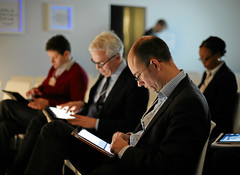While I believe in the efficiency of webinars, conferences and conference calls, I also have multi-tasked my way through all of them enough times to know that they are not usually the best way to have an engaged conversation. As with so many things related to communications, the closer you can get to face-to-face, one-on-one conversation, the more impact and persuasion you can have. The closer we can get to one-on-one conversation the more likely we are to make a connection with the other party in the conversation.
A friend of mine sends out emails about her business on a pretty regular basis. She was telling me that she had recently started personalizing some of the emails to key customers. The response from those customers was remarkable, she told me with a bit of amazement. While not everyone made a purchase, many people felt the need to respond to her; to reconnect with her. They saw these emails not as advertisements, which they essentially were, but as one-on-one communications. As a personal message. They felt compelled to respond. They felt compelled to strengthen the relationship.
There are ways that technology can help us approximate the one-on-one conversation. For a while, one of the biggest concepts in marketing was the idea of mass customization. The theory was that technology would allow us to use the convenience of mass marketing but with the impact of a personalized, customized message. While I suspect there aren't many people anymore who feel that a mail merged letter is the same as a hand-written note, it does make a letter seem a bit less like a form letter and a bit more like the sender wants to really communicate. Technology allows us to customize what information a customer or prospect receives, essentially allowing us to customize our interaction on a one-on-one level.
We need to be mindful of what we are doing and not let the technology seduce us too much. For example, think about how too many people use what is now a pretty dusty technology, PowerPoint. Too many speakers continue to pour all of their energy into creating detailed, bullet-riddled PowerPoint presentations. They end up giving their speech facing the slides because they don't want to miss any of the precious facts they have loaded onto each slide. As Seth Godin says in his blog post titled "Really Bad PowerPoint," "countless innovations fail because their champions use PowerPoint the way Microsoft wants them to, instead of the right way." Wordy, bullet-laden presentations rarely communicate as much as the creator hopes they will. When a speaker is speaking to the screen, he cannot be talking with the audience. Also, people can't see all the brilliance on the slide if their eyes are closed.
Similarly, some organizations confuse the use of social media as a strategy as opposed to a media option. This results in companies focusing unwarranted attention on generating likes, or followers, or repins instead of focusing on the true mission of the organization or the brand, generating sales. Getting someone to push a "Like" button is not a conversation or a connection. It may be an invitation to start a conversation, depending what scheme you used to get that person to push that "Like" button. We really need to be focusing on connections, real connections, with customers and prospects and other key audiences. We need to be finding ways to talk together.
A colleague of mine told me recently that if an email exchange goes past three emails without the issue getting resolved, she picks up the phone and calls the person. The issue rarely goes past one phone call. There is nothing more powerful than talking directly with a person.



Thanks for the shout out! I think that's the core of my business, relationships. Growing up, I didn't live someplace where it was easy to make friends. Consequently, I learned that I had to reach out if I wanted anyone to connect with me. A hard lesson, but very effective as I've gotten older.
ReplyDelete